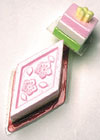 How to make a J-Girl How to make a J-Girl
By Catherine E. Toth
Advertiser Staff Writer
There’s one date every girl loves.
No, we’re not talking about a date with Ben Affleck.
It’s March 3, the date when girls rule.
 Girls’ Day is a celebration of spring in Japan, when the ornamental peach trees are in bloom. Traditionally, dolls are given to girls on their first Hinamatsuri (Girls’ Day) by relatives, typically grandparents. These dolls, called hina ningyo, are displayed on shelves, traditionally in the best room of the house. The most valued dolls are the dairisama, ones that depict an emperor and empress dressed in silk costumes. Girls’ Day is a celebration of spring in Japan, when the ornamental peach trees are in bloom. Traditionally, dolls are given to girls on their first Hinamatsuri (Girls’ Day) by relatives, typically grandparents. These dolls, called hina ningyo, are displayed on shelves, traditionally in the best room of the house. The most valued dolls are the dairisama, ones that depict an emperor and empress dressed in silk costumes.
Peach blossoms traditionally adorn the hina ningyo, not only for their beauty but because the blossoms symbolize the virtues and characteristics traditionally desired in little girls and young women: beauty, grace, sweetness, serenity and gentleness.
But the real value of this event is in the tradition. In most Japanese households, the dolls are handed down from mother to daughter as family heirlooms.
See how special being a girl is?
In honor of Hinamatsuri - and females everywhere - create your own finger puppet J-girl, complete with a design-yourself kimono.
Girl power!
 Foods for a memorable Girls’ Day Foods for a memorable Girls’ Day
Not everyone collects dolls.
But instead of shrugging off the traditional Japanese holiday altogether, here are some Hinamatsuri gifts sure to be mood-enhancers on March 3:
- Washi Hina Arare: Puffy rice crackers dolled up in a pretty-in-pink package ($3, Shirokiya).
- Kokeshi Arare: Crunchy rice crackers dressed as Hinamatsuri dolls ($4.50, Shirokiya).
- Hinaasobi Watagashi: Otherwise known as "cotton candy," this unconventional gift comes in a fun, bright Hinamatsuri package perfect for the occasion ($4, Shirokiya).
Colored candies embody female traits
Ever wondered about those diamond-shaped, tri-color sweets you see at Shirokiya and Marukai at this time of year?
Well, so did we.
Turns out that they are actually special forms of glutinous rice cake, traditionally eaten on March 3. Called hishi mochi, the three pieces of cake are stacked according to color: green on the bottom, white in the middle and pink on top.
 As with most things Japanese, these colors are symbolic. As with most things Japanese, these colors are symbolic.
Green is for the freshness of summer, or fertility. White symbolizes the snow of winter, or purity. Pink represents the flowers of spring, or energy. (Autumn is not represented, as it is hoped there would be no autumn in their lives.)
The hishi mochi is often displayed with the Hinamatsuri dolls, called hina ningyo, along with hina arare (sweetened pink and white puffed rice) and shiro zake (sake mixed with rice malt).
 Want to learn more about kimonos? Want to learn more about kimonos?
Here’s a list of Web sites that allow you to explore - in some cases, create - the traditional Japanese garments:
- jin.jcic.or.jp/kidsweb/virtual/kimono/virtual.html: Kids Web Japan, created by the Japan Information Network, has a virtual kimono game in which you can chose patterns for the kimono and obi, and even pick out a matching purse or umbrella. Best of all, you learn a little something about the significance of each kimono type and pattern.
- www.picky.or.jp/user/kotobuki: Kimon O’ Gram, by C.S. Kotobuki, allows you to send an unconventional e-card with a kimono in a setting you pick yourself. Don’t expect state-of-the-art graphics, though. This simple site is simply for fun.
[back to top] |

 The Great Index to Fun
The Great Index to Fun Girls’ Day is a celebration of spring in Japan, when the ornamental peach trees are in bloom. Traditionally, dolls are given to girls on their first Hinamatsuri (Girls’ Day) by relatives, typically grandparents. These dolls, called hina ningyo, are displayed on shelves, traditionally in the best room of the house. The most valued dolls are the dairisama, ones that depict an emperor and empress dressed in silk costumes.
Girls’ Day is a celebration of spring in Japan, when the ornamental peach trees are in bloom. Traditionally, dolls are given to girls on their first Hinamatsuri (Girls’ Day) by relatives, typically grandparents. These dolls, called hina ningyo, are displayed on shelves, traditionally in the best room of the house. The most valued dolls are the dairisama, ones that depict an emperor and empress dressed in silk costumes. Foods for a memorable Girls’ Day
Foods for a memorable Girls’ Day As with most things Japanese, these colors are symbolic.
As with most things Japanese, these colors are symbolic. Want to learn more about kimonos?
Want to learn more about kimonos?